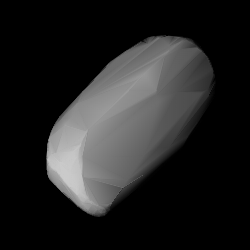 Modelled shape of Manto from its lightcurve | |
| Discovery [1] | |
|---|---|
| Discovered by | M. F. Wolf |
| Discovery site | Heidelberg Obs. |
| Discovery date | 12 May 1917 |
| Designations | |
| (870) Manto | |
| Pronunciation | /ˈmæntoʊ/ |
Named after | Μαντώ Mantō(Greek mythology) [2] |
| A917 JC ·1935 NB 1935 QV ·1953 UE1 A907 TF ·A914 UC 1917 BX ·1907 TF 1914 UC | |
| Adjectives | Mantoian /mænˈtoʊ.iən/ [6] |
| Orbital characteristics [3] | |
| Epoch 31 May 2020 (JD 2459000.5) | |
| Uncertainty parameter 0 | |
| Observation arc | 102.14 yr (37,307 d) |
| Aphelion | 2.9379 AU |
| Perihelion | 1.7065 AU |
| 2.3222 AU | |
| Eccentricity | 0.2651 |
| 3.54 yr (1,293 d) | |
| 343.87° | |
| 0° 16m 42.6s / day | |
| Inclination | 6.1928° |
| 120.80° | |
| 196.89° | |
| Physical characteristics | |
| 122.30±0.01 h [9] | |
Pole ecliptic latitude | |
| 11.7 [1] [3] | |
870 Manto (prov. designation: A917 JCor1917 BX) is a stony background asteroid and slow rotator from the inner region of the asteroid belt. It was discovered on 12 May 1917, by astronomer Max Wolf at the Heidelberg Observatory in southwest Germany. [1] The likely heavily elongated S-type asteroid has a long rotation period of 122.3 hours and measures approximately 13 kilometers (8 miles) in diameter. It was named after Manto, a prophetess in Greek mythology. [2]